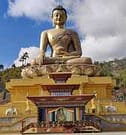Lesson 2
Watch Your Breath
You are now able to sit in a stable posture. Your legs are folded crosswise, the spine is erect, and the head is held straight. You are comfortable and relaxed, aware of your surroundings, and attuned to your body.
Observing the Breath
Watch your breath.
Be aware of the sensation of the breath around your nostrils as you breathe in and out.
- Mindfully breathe in. Mindfully breathe out.
If your breath feels subtle and hard to notice, take a few deep breaths. Pay attention to the incoming and outgoing breath at the two doorways of your nostrils. This is the in-breath, and this is the out-breath. Be aware of each breath as it flows in and out.
Focus your attention around the nostrils, like a watchman at the entrance of an apartment, observing each visitor who enters or leaves. Allow no breath to pass unnoticed.
Natural Breathing
Do not attempt to regulate your breath in any way. Simply observe your natural breath as it is. Be an observer, a silent spectator. Watch your breath as you inhale and as you exhale.
- Breathing in long, recognise: I am breathing in long.
- Breathing out long, recognise: I am breathing out long.
- Breathing in short, recognise: I am breathing in short.
- Breathing out short, recognise: I am breathing out short.
If the in-breath feels cool, acknowledge it as cool. If the out-breath feels warm, acknowledge it as warm. Watch your breath with focused intent.
If the breath is shallow, know: it is shallow. If it is deep, know: it is deep.
- Mindfully breathe in. Mindfully breathe out.
Addressing Wandering Thoughts
It is natural for the mind to wander as you begin meditating. Do not be discouraged.
If your mind drifts, gently guide your attention back to your breath at the nostrils. If it happens again, return your focus to your breath, always with patience and kindness.
Watching the breath as it moves in and out dispels distractions and nurtures concentration. With consistent practice, your concentration will grow deeper and steadier.
Building the Practice
Begin with sessions of 15 to 20 minutes, gradually increasing the duration as you grow more comfortable. Remember, your task is not to manipulate the breath but to observe it in its natural state.
- Always mindful, breathe in. Mindfully, breathe out.
When you are ready, gently open your eyes and emerge from meditation.
A Strong Foundation
Focusing on the in-breath and out-breath develops concentration. Dedicate yourself to this practice for a couple of weeks. As you become comfortable, you will be ready to progress to the next step.
Do not rush. The more time you invest in this foundational step, the stronger your base will be for higher stages of meditation.
© Jagat Singh Bisht
(Master Teacher: Happiness & Well-Being, Laughter Yoga Master Trainer, Author, Blogger, Educator, and Speaker.)
Founder: LifeSkills
A Pathway to Authentic Happiness, Well-Being & A Fulfilling Life! We teach skills to lead a healthy, happy and meaningful life.
The Science of Happiness (Positive Psychology), Meditation, Yoga, Spirituality and Laughter Yoga. We conduct talks, seminars, workshops, retreats and training.
≈ Editor – Shri Hemant Bawankar/Editor (English) – Captain Pravin Raghuvanshi, NM ≈








